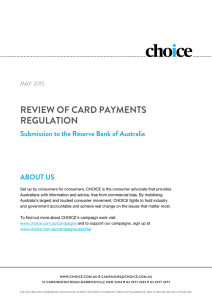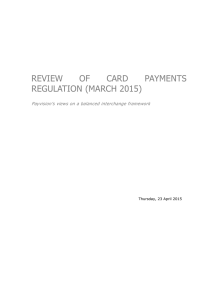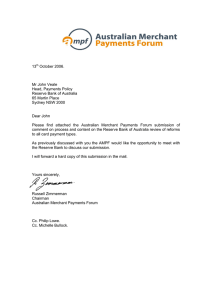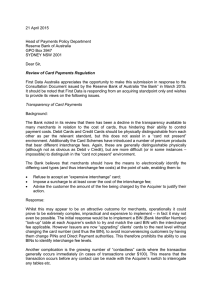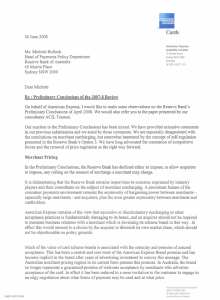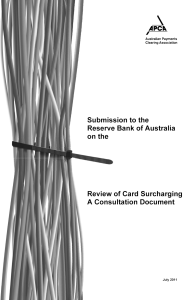REVIEW OF CARD PAYMENTS REGULATION Submission to the Reserve Bank of Australia
advertisement
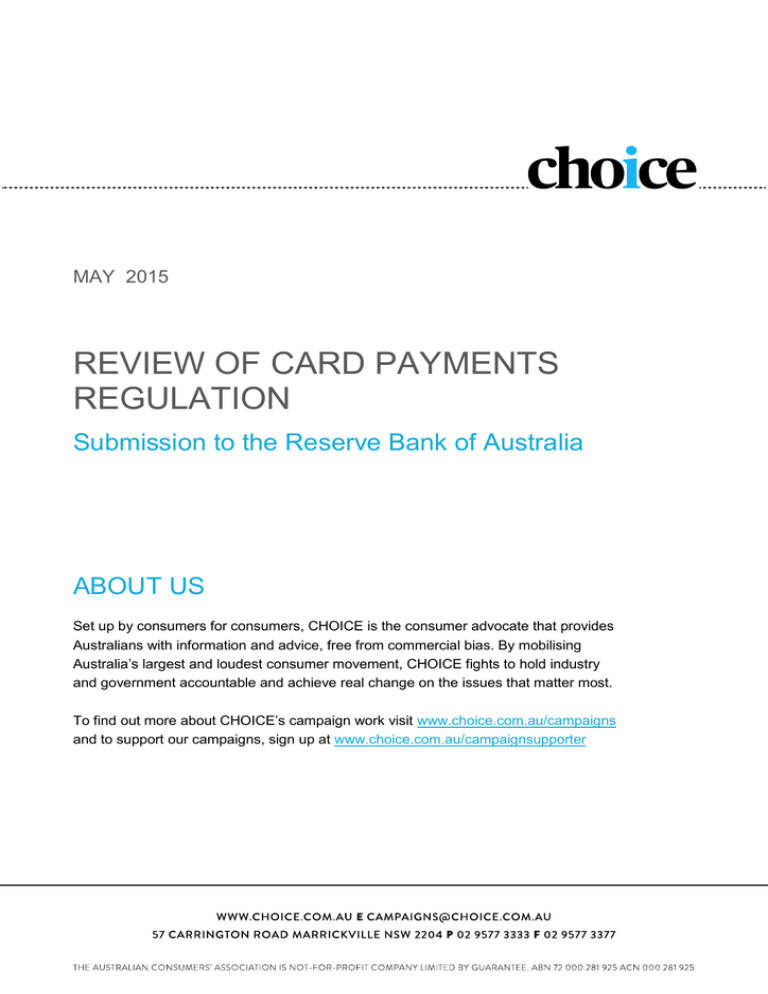
MAY 2015 REVIEW OF CARD PAYMENTS REGULATION Submission to the Reserve Bank of Australia ABOUT US Set up by consumers for consumers, CHOICE is the consumer advocate that provides Australians with information and advice, free from commercial bias. By mobilising Australia’s largest and loudest consumer movement, CHOICE fights to hold industry and government accountable and achieve real change on the issues that matter most. To find out more about CHOICE’s campaign work visit www.choice.com.au/campaigns and to support our campaigns, sign up at www.choice.com.au/campaignsupporter CONTENTS INTRODUCTION ....................................................................................................................... 3 1. Surcharging ............................................................................................................................ 4 2. Transparency measures ........................................................................................................ 5 3. Merchant Routing................................................................................................................... 6 INTRODUCTION CHOICE appreciates the opportunity to respond to the Review of Card Payments Regulation Issues Paper. Australia has a relatively low cost payments system by international standards.1 This signals that recent reforms are largely working. CHOICE encourages the Reserve Bank of Australia (RBA) to continue to pursue reforms that reduce the cost of payments for all parties. While the overall payments system is working, specific areas of concern persist. The most pressing issue for consumers, as evidenced by the number of submissions received by the Financial System Inquiry on the matter, is surcharging on card payments. Excessive surcharging has been discussed and assessed for a number of years. It is now time for action. CHOICE strongly encourages the RBA to support an enforcement measure. There should be commercially significant penalties for those businesses clearly flouting the surcharging rule. Without penalties for non-compliance we expect that excessive surcharging will continue. The RBA has an obligation to ensure that the payments system works in the public interest. Given this, CHOICE finds it strange that merchant routing is being considered as a viable option. This option would remove consumer choice and dramatically reduce the ability of consumers to increase competitive pressure on payment systems. Because payment systems offer different services for consumers, they cannot be switched as like-for-like products. Merchant routing would likely frustrate and disadvantage the ultimate end-users of payment systems, consumers. 1 Issues paper p.24 CHOICE | Review of Card Payments Regulation 3 1. Surcharging Surcharging can improve the efficiency of the payments system when it provides accurate price signals to consumers. However, for this to occur, surcharging must reflect the costs incurred by the merchant. It is obvious that some businesses are charging excessive surcharges. This problem has been discussed for a number of years. In CHOICE’s March 2014 nationally representative survey of Australian financial system consumers, 86% identified ‘reducing excessive credit card surcharges’ as their priority for the Financial System Inquiry, second only to ‘increasing protection for consumers’ (89%).2 Action is needed. CHOICE supports fair surcharging. Any return to a “no surcharge” regime would shift the costs from consumers who choose a specific payment type to all consumers, as costs are absorbed into the overall price of goods and services. Such a change would disadvantage consumers using lower cost payment methods like eftpos or cash while subsidising users of higher cost credit cards. The tiered surcharging recommendation does not address excessive surcharging CHOICE does not support the tiered surcharging recommendation. The recommendation presented in the Final Report of the Financial System Inquiry would increase complexity while failing to solve the enforcement issue in the current system. The proposal does not specify what cards would be subject to surcharge limits or how merchants and consumers could identify each tier of cards at the point of payment. Targeted changes are needed to eliminate excessive surcharging It is clear that a small number of large businesses are not complying with the current rule on surcharging. 3 Some of Australia’s largest businesses, who are best able to negotiate low merchant service fees, are charging some of the highest card payment surcharges. This indicates that without some form of enforcement, businesses with substantial market power and little competitive pressure will continue to apply excessive surcharges. Given this, CHOICE is The survey was conducted between 20-23 March 2014 with 1048 Australians aged 18+ from a permission-based panel (Pureprofile). Of these, 1005 indicated they had at least one of the following: everyday transaction account (and/or any offset account used for everyday transactions), home loan, credit card and savings account or term deposit. A nationally representative sample was drawn based on population data sourced from ABS Census 2011, and the final sample was weighed by age group, gender and location. 3 RBA, March 2013, Reforms to Payment Card Surcharging http://www.rba.gov.au/payments-system/surcharging/index.html 2 CHOICE | Review of Card Payments Regulation 4 not convinced that a cap alone, either percentage-based or at a fixed-dollar amount, would address excessive surcharging. CHOICE maintains that a principles-based rule can be enforced by a regulator that has powers to demand documents and issue commercially significant penalties for non-compliance. Equally, costs can be reduced if a regulator is provided with appropriate enforcement power and focuses on egregious breaches of the rule. It is likely that a small number of regulatory actions would drive substantial change to surcharging practices. CHOICE believes a solution to excessive surcharging could be implemented in one of two ways: 1) The government amends legislation to allow a regulator, ideally the Australian Competition and Consumer Commission or the Australian Securities and Investments Commission, to enforce the surcharging rule. This option is likely to be the most effective approach as it would allow a consumer-focused regulator to issue substantiation notices on likely excessive surcharges, demand documents and issue commercially significant penalties for non-compliance. 2) That the RBA amend the surcharging rule so that no card payment processing fee can be greater than the merchant service fee. This would make it easier to determine whether a surcharge is excessive. This change could possibly allow the ACCC to take action using its current powers. If a surcharge did not match the costs incurred by the business it could be misleading or deceptive behaviour on the part of the business. This option would have to be thoroughly explored with the ACCC to determine feasibility. This option may have an additional incentive – it would increase transparency of merchant service fees and place pressure on costs across the system. Alongside introducing an enforcement mechanism, the RBA can increase effectiveness of surcharging by requiring that at least one commonly available payment option is available for free (preferably eftpos and debit payments). 2. Transparency measures The current interchange and merchant service fee system is confusing and complex. Merchants need to be able to quickly determine whether a payment is about to be made by credit or debit in order to apply a fair surcharge. The inability of merchants to distinguish between credit and CHOICE | Review of Card Payments Regulation 5 debit cards at the point of payment leads to blended surcharging for debit and credit, even though the cost difference between the two is often significant. Given these difficulties, CHOICE supports measures that would improve transparency. We favour options that would build on new European Union payments regulation which make cards with different interchange fees easily identifiable visually and electronically. In addition, CHOICE supports changes to allow Australian merchants to inform customers of their cost of card acceptance. These changes are necessary to increase competitive pressure across the card payments system and to allow for accurate and fair surcharging. If the RBA decides against increasing transparency in this way, public companies (over a certain size to exclude small business) should be required to report annually on the total amount collected in card surcharges and total amount paid in merchant service fees. This will allow a more transparent evaluation of the gap between average merchant fees and total surcharges. This measure will assist any regulator responsible for assessing the reasonableness of surcharges and provide consumers with transparency about surcharge collection. 3. Merchant Routing CHOICE strongly opposes the proposal to allow merchants to route payments over their preferred network. CHOICE’s understanding of this proposal, as described by merchant submissions to the Financial System Inquiry consultations, is that it would remove consumer choice.4 This paper does not consider the impact of merchant routing on consumers, either on their personal finances or in their role as agents with the ability to drive change and increase competitive pressure in any market. There are practical differences with payment systems for consumers including different surcharges at the point of sale, different security guarantees in case of fraud and the ability to use additional features such as withdrawing cash at a checkout. The most prominent difference is when the payment is deducted from a consumer’s bank account. Eftpos payments are deducted automatically while Visa and MasterCard debit payments can take several days before the payment is finally processed. If the merchant routing proposal goes ahead, businesses could override consumers’ decisions about how to manage their personal finances. 4 Australian Retailers Association, March 2014, Submission to the FSI, p 7. CHOICE | Review of Card Payments Regulation 6 The most effective way of addressing the issue of different costs a merchant incurs to accept different payment types is to continue the current system which allows a merchant to send price signals to consumers through surcharging based on the reasonable costs of accepting a payment. Should a merchant find a payment option too expensive they are currently able to refuse to accept that payment type or charge a reasonable surcharge, rather than offer consumers one option and deliver another.5 Decision to allow merchant routing potentially unreasonable We believe that any decision to allow merchant routing could be considered unreasonable as it fails to consider that different payment systems provide different services with different features, and thus cannot be readily swapped without an impact on the service a consumer receives. The legal test for proving unreasonableness in decision making is quite high; it requires that a decision should be so absurd that no sensible person would dream it lay within the powers of the authority.6 However, as merchant routing would see a consumer select one service and be delivered another we believe it is possible that an RBA decision to allow merchant routing could be seen as unreasonable. If it holds that payment systems offer different services to consumers, then it possible that a sensible person would find it absurd that the Reserve Bank would create a scenario where a consumer could make one choice and a merchant could force another. CHOICE encourages the RBA to prevent merchant routing. Separation of scheme activities and processing infrastructure will increase competition As noted in the paper, contactless (or ‘tap-and-go') point-of-sale transactions are becoming more widely used. Because this technology currently only allows certain payment types (typically Visa and MasterCard), consumers are no longer actively choosing payment type and network at the terminal, although the choice to enter a PIN and pay with multiple methods remains. 5 While Woolworths’ decision to preference eftpos payments from 2010-2012 is often given as an example of merchant routing, in practice Woolworths removed the option to pay by debit, allowing consumers only to choose cheque or savings. This is a different solution to businesses appearing to offer debit payments but routing regardless. See http://www.crn.com.au/News/171068,woolworths-dumps-visa-mastercard-debit.aspx and http://www.lifehacker.com.au/2012/09/woolworths-accepting-debit-credit-cards-again/ 6 See Australian Retailers Association v Reserve Bank of Australia [2005] FCA 1707 paragraph 550. CHOICE | Review of Card Payments Regulation 7 CHOICE recognises this as a problem. Merchant routing is not a solution. Instead, consumers should be given increased choice about the way they pay. This could be achieved by allowing consumers who have cards with multiple payment options (dual or multi-network arrangements) to choose which payment method they prefer when using contactless technology. This could be facilitated by the card issuer, either through online banking or ATM terminals. CHOICE would welcome further consideration of a rule which would require the legal separation of scheme activities and the processing infrastructure of card networks. This option could continue to deliver innovative payment options to Australians without locking payments technology to certain card networks. Equally, CHOICE supports further consideration of rules that would prevent the restriction of different payment options being included on an application or mobile device. CHOICE | Review of Card Payments Regulation 8
